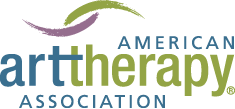PROTECTING THE PUBLIC
Art therapists are clinicians with master’s-level or higher degrees trained in art and therapy that serve diverse communities in different settings — from medical institutions and wellness centers, to schools and independent practices.
Guided by ethical standards and scope of practice, their education and supervised training prepares them for culturally proficient work with diverse populations in a variety of settings. They are credentialed mental health care professionals who care deeply about the communities they support, helping to advance people’s mental, emotional, and physical well-being.

KNOWLEDGE AND COMPETENCE
Art therapy credentials ensure that art therapists have the in-depth knowledge, professional and ethical competence, and proven work experience to deliver high-quality mental health care while adhering to ethical guidelines.
When seeking an art therapist, look for their credentials: ATR (art therapist registered) or ATR–BC (board–certified art therapist registered). These credentials are regulated by the Art Therapy Credentials Board (ATCB) to ensure competence, professionalism, and ethical practice. The ATCB administers the only accredited high-stakes art therapy exam, with its credentials increasingly required for state licensure and gaining international recognition.
ACCOUNTABILITY
The practice of art therapy is regulated with art therapy licenses in 15 states and the District of Columbia. Art therapists hold professional art therapy licenses in Connecticut, Delaware, the District of Columbia, Kentucky, Maryland, Mississippi, New Jersey, New Mexico, Oregon, Tennessee, and Virginia.
In addition, they are regulated under related professional licenses in Texas, New York, Pennsylvania, Wisconsin, and Utah. In Arizona, Louisiana, and New Hampshire, art therapists are recognized for purposes of state hiring and/or title protection.
Licensed art therapists are accountable for their practice according to rules and regulations of their state’s licensing board. They must maintain their license in good standing and renew their license regularly.
INACCURATE USE OF TERM ‘ART THERAPY’
Inaccurate use of “art therapy” often occurs due to a lack of knowledge about the profession. Such instances provide an opportunity to offer accurate information and educate the public. It is with this in mind that the AATA encourages outreach to individuals and/or companies that may be found to inaccurately categorize activities (such as trainings that are offered by non-art therapists) or products (such as adult coloring books) as “art therapy.”
EXAMPLE ACTIVITIES
IN ADVERTISING
On occasion, non-art therapist practitioners might be found to advertise their services as “art therapy.” This is an inaccurate use of the term, as art therapy can only be practiced by an individual who possesses the required training, certification, and/or state licensure. Bona fide art therapy is beyond the scope of practice of non-art therapists.
IN WORKSHOPS
Another context in which art therapy may be inaccurately categorized includes professional trainings that furnish a certificate upon completion, which may mislead the participant to believe that he or she can practice art therapy. These sorts of trainings, workshops, and the like, give attendees the erroneous impression that art therapy is a modality rather than a profession.
To prevent this problem, facilitators are advised to adhere to the AATA’s Ethical Principles: “When providing training and/or supervision to non-art therapists, art therapists take precautions to ensure that trainees understand the nature, objectives, expectations, limitations, and resulting qualifications of the supervision and/or training as distinct from formal studies in art therapy” (8.6). As such, a disclaimer should be used to alert attendees accordingly.
EXAMPLE PRODUCTS
Several products on the market may inaccurately identify the term “art therapy.” Two such examples include art therapy apps and art therapy coloring books.
IN ADULT COLORING BOOKS
While the AATA does not discourage the use of coloring books for recreation and self-care, coloring activities must be distinguished from art therapy services provided by a credentialed art therapist. Review the AATA’s official statements for details:
- Art Therapy and Coloring Books: AATA Draws the Line, January 2016
- The Adult Coloring Book Phenomenon, August 2015
For those interested in more information, the following articles provide accurate representations of both art therapy and adult coloring books:
- “Adult Coloring Books: A Safe Space to Play with Color” by Conan Milner for the Epoch Times, February 2016
- “Color Me Cautious: Don’t Mistake Adult Coloring Books for Art Therapy” by John Diconsiglio for the Columbian College of Arts & Sciences, February 2016
- “Adult Coloring Books” (Video) with Dr. Val Huet, the British Association of Art Therapists (BAAT) Chief Executive Officer for Reuters TV, December 2015
ADDRESSING CONCERNS ABOUT REPRESENTATION OR SERVICES
If you encounter an individual who may be erroneously identifying themselves as an art therapist, please review this fact sheet.
Professional credentials in art therapy can be verified through the Art Therapy Credentials Board.
